|
|
|
Sort Order |
|
|
|
Items / Page
|
|
|
|
|
|
|
| Srl | Item |
| 1 |
ID:
188580
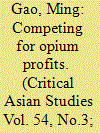

|
|
|
|
|
| Summary/Abstract |
This paper highlights the lives of Japanese and Korean subjects of Imperial Japan who were involved in opium production and circulation in Manchukuo. It discusses the dynamics, practices, and experiences of opium production and circulation. This paper provides a new reading of the diverse beneficiaries on the ground and of the opium industry in Manchukuo from the angles of production and circulation. Even as authorities continued to make significant revenue from the opium trade, the opium industry provided opportunities for diverse actors to profit from taking part in the state opium monopoly scheme. The interplay of these actors eroded Japanese imperial control over the new state. By dissecting the entanglement of the complex nature of the opium industry within a regional context, the paper demonstrates how the state actors were compelled to take action to combat illegal opium growing and selling.
|
|
|
|
|
|
|
|
|
|
|
|
|
|
|
|
| 2 |
ID:
124520
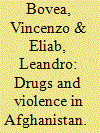

|
|
|
|
|
| Publication |
2013.
|
| Summary/Abstract |
This paper addresses the relationship between the level of violence and the opium market in Afghanistan's provinces. We first provide an overview of the nature and extent of the Afghan drug trafficking. This is followed by a vector autoregressive analysis of the nexus opium-insurgency activities using monthly time-series data on opium prices and the number of security incidents for 15 Afghan provinces over the period 2004-2009. We use a multifactor error structure, the common correlated effect, to include unobservable common factors; Impulse Response functions to describe the time path of the dependent variables in response to shocks; and the mean group estimator to summarize our results across the provinces. Results suggest a conflict-induced reduction in opium prices, while the reverse opium-violence mechanism is mostly negligible. Moreover, unobservable common factors are the main drivers of opium prices and violence.
|
|
|
|
|
|
|
|
|
|
|
|
|
|
|
|
| 3 |
ID:
186733
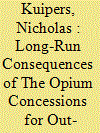

|
|
|
|
|
| Summary/Abstract |
This article examines the consequences of the opium concession system in the Dutch East Indies—a nineteenth-century institution through which the Dutch would auction the monopolistic right to sell opium in a given locality. The winners of these auctions were invariably ethnic Chinese. The poverty of Java's indigenous population combined with opium's addictive properties meant that many individuals fell into destitution. The author argues that this institution put in motion a self-reinforcing arrangement that enriched one group and embittered the other with consequences that persist to the present day. Consistent with this theory, the author finds that individuals living today in villages where the opium concession system once operated report higher levels of out-group intolerance compared to individuals in nearby unexposed counterfactual villages. These findings improve the understanding of the historical conditions that structure antagonisms between competing groups.
|
|
|
|
|
|
|
|
|
|
|
|
|
|
|
|
| 4 |
ID:
118593
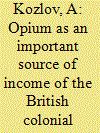

|
|
|
|
|
| Publication |
2012.
|
| Summary/Abstract |
On the basis of official documents of the colonial administration of Hong Kong, the article describes the policy of the British colonialists in Hong Kong using opium as a legal source of income in the first half of the 20th century. Despite decisions of several international conferences on control over drug trafficking, beginning from the Shanghai Opium Commission whose centenary was marked in 2009, Britain widely used opium for financial support of its rule in China, and stopped it only in 1945 under U.S. pressure.
|
|
|
|
|
|
|
|
|
|
|
|
|
|
|
|
| 5 |
ID:
103966


|
|
|
|
|
| Publication |
2011.
|
| Summary/Abstract |
The collapse of the Soviet Union precipitated the massive expansion of drug use and trade in Russia. The country now has one of the largest populations of injecting drug users in the world and has become the largest single-country market for Afghan heroin. In 2003 the Federal Service for the Control of the Drugs Trade was created to coordinate a comprehensive counternarcotics strategy appropriate to the scale of this threat. The service continues to face a number of challenges in its early stages of development. However, it has made considerable advances in improving responses to large-scale organised crime and in building international cooperation.
|
|
|
|
|
|
|
|
|
|
|
|
|
|
|
|
| 6 |
ID:
158204
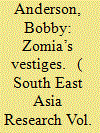

|
|
|
|
|
| Summary/Abstract |
Opium poppy cultivation in Thailand fell from 12,112 hectares in 1961 to 281 hectares in 2015. One outlier exists: Chiang Mai Province’s remote southwestern district, Omkoi. Ninety percent of the district is a national forest reserve where human habitation is illegal. However, an ethnic Karen population has lived there since long before the law that outlawed them was created, unconnected to the state by road, with limited or no access to health, education and other services. Omkoi’s Karen increasingly rely on cash-based markets. Their lack of citizenship precludes them from land tenure that might incentivize them to grow alternative crops, and their statelessness precludes them from services and protections. Nor is the Thai state the singular Leviathan that states are often assumed to be; it is a collection of agencies and networks with divergent interests, of whom one of the most powerful, the Royal Forestry Department, has purposely made Omkoi’s population illegible, and has consistently blocked the attempts of other state actors to complexify Omkoi beyond the simplicity of its forest environment. These factors make the state illegitimate to Omkoi’s Karen just as Omkoi’s Karen are illegitimate to the state, and make the cultivation of short-term, high-yield, high-value, imperishable opium a logical economic choice for poor Karen farmers, especially given the historical lack of law enforcement presence. However, that presence is growing, as Omkoi becomes one of the last areas of Thailand to experience the historical extension of lowland Padi state power into an ungoverned, untallied highland.
|
|
|
|
|
|
|
|
|
|
|
|
|
|
|
|
|
|
|
|
|